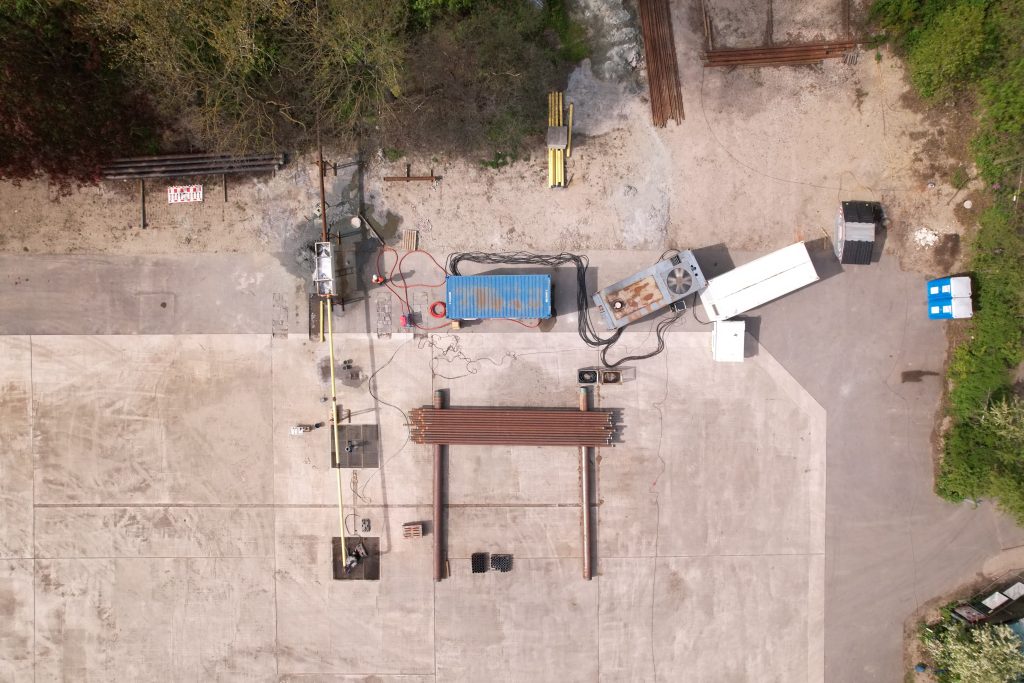 Top view of the well site during production testing at the Wilhelmsburg geothermal project in Hamburg, Germany (source: Hamburg Energie Geothermie)
Top view of the well site during production testing at the Wilhelmsburg geothermal project in Hamburg, Germany (source: Hamburg Energie Geothermie)Construction of the boiler house is expected to start by the spring of 2024. Heat supply is then planned to start by spring 2025.
Based on the tests and the technical planning of the geothermal plant, experts expect a purely geothermal heat output of around 6 MW. This will be enough to supply 4700 households. With the planned multi-stage heating process, the number of households supplied can be increased to over 6,000. The injection test, in which the pumped thermal water is fed back into the 130 meter thick sandstone layer via a second borehole, was also successful.
We had closely reported on the Hamburg geothermal project starting from the promising results of the first exploration drilling and the commencement of the drilling of the second well. The project is being developed by Hamburg Energie Geothermie GmbH, now a wholly owned subsidiary of Hamburger Energiewerke GmbH.
“Wilhelmsburg is a good example of the importance that district heating networks can have in future climate-neutral heat supply for households. Since geothermal energy has not yet been researched much in northern Germany, my thanks go in particular to the Federal Ministry of Economics and the scientific support. Only in this way could this project be made possible and can now make a valuable contribution to the further use of geothermal heat in northern Germany,” said Michael Prinz, Managing Director of Hamburger Energiewerke GmbH.
District heating expansion
With the new geothermal heating plant in the horizon, there are now plans to expand the Wilhelmsburg heating network. Two existing heating networks are to be merged and expanded – Energiebunker and Energieverbund. The possibility of expanding the geothermal project is also being evaluated.
“With the merger of the local heating networks in Wilhelmsburg-Mitte with the new geothermal plant – a large district heating network of HEnW is created on the Elbe island. This is an important step in the expansion of district heating in Hamburg and the consistent continuation and further development of the IBA project ‘renewable Wilhelmsburg’. And the project is a special example of the heating network expansion with renewable energies as a whole. As part of municipal heating planning, it is important for us to show area-specific, climate-neutral supply options,” commented Jens Kerstan, Senator for the Environment, Climate, Energy and Agriculture.
Insight into geothermal in North Germany
The Hamburg geothermal project is part of the real laboratory IW3 – Integrated Heat Transition Wilhelmsburg, which aims to supply Wilhelmsburg residential areas with heat that is almost CO2-free. As a “real laboratory of the energy transition”, the Federal Ministry of Economics and Climate Protection (BMWK) is funding the project with a total of EUR 22.5 million to support research and development in the field of future-oriented energy technologies.
The mesoTherm joint project was able to obtain extensive data from the exploratory drilling as part of the IW3 project. This will contribute to further gaining knowledge of geothermal energy in the North German Basin. The mesoTherm project is being carried out under the leadership of the Georg-August University of Göttingen, Geosciences Center, together with Geothermie Neubrandenburg GmbH (GTN) and the Leibniz Institute for Applied Geophysics (LIAG) as an associated partner and has the central goal of gaining knowledge to contribute about the geothermal reservoirs in northern Germany and their possible energetic use.
“Research on geothermal energy in Hamburg-Wilhelmsburg has also brought us very far scientifically. We have discovered a geological formation that we can further develop for medium-deep geothermal energy. The projects in Schwerin and Potsdam have also tapped into rocks with 40 to 60 degrees Celsius geothermal heat at medium depths and they show: This is where the future of heat supply in Germany lies,” said Inga Moeck, professor of geothermal energy at the Georg-August University of Göttingen and head of the geothermal energy department at LIAG.